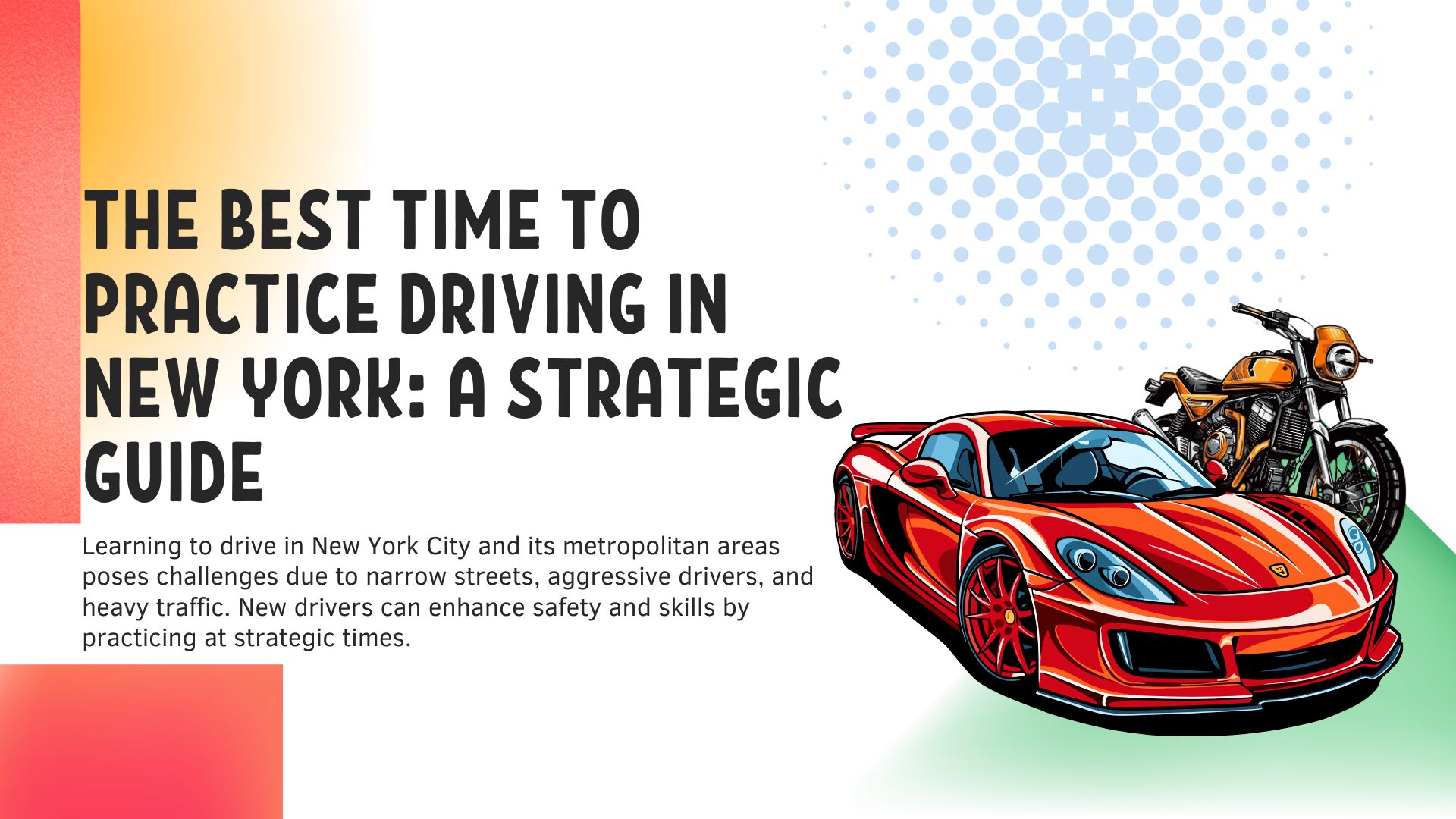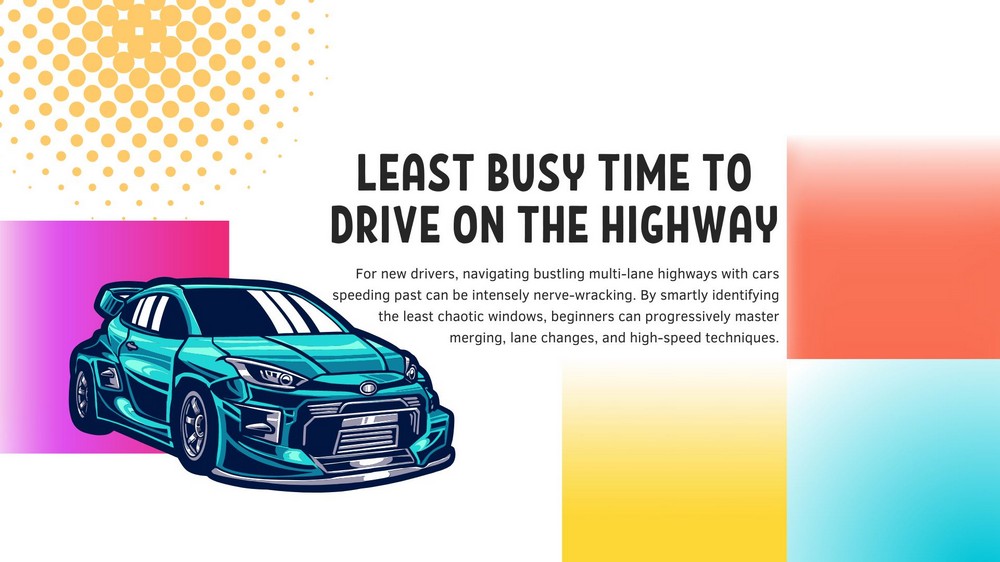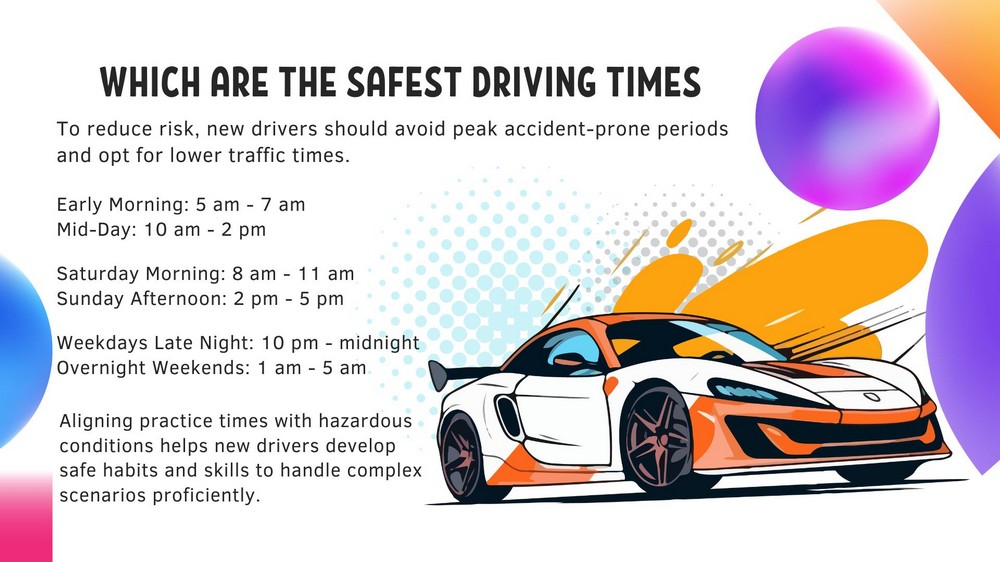The Best Time to Practice Driving in New York: A Strategic Guide

Table of Contents
- Why Timing Matters
- Start With Early Weekend Mornings
- The Best Time to Practice Driving
- When Is The Wrong Time To Practice Driving
- What Time of the Day Are Roads Least Busy
- Least Busy Time to Drive on the Highway
- What Are Three Dangerous Times To Be Driving
- What Time is There the Least Traffic
- What Is The Best Day Of The Week To Drive
- What Are the Most Challenging Driving Times
- How Many Practice Hours Are Recommended for Driving
- Which Are the Safest Driving Times
- Choosing Optimal Windows - The Key to NYC Driving Readiness
Learning how to drive in New York City and its surrounding metropolitan areas presents unique challenges for new drivers. With its narrow streets, aggressive drivers, and seemingly endless traffic, simply getting behind the wheel can be an intimidating prospect. However, by strategically choosing the right times to practice, new drivers can greatly improve their chances of staying safe while efficiently developing core driving competencies.
Why Timing Matters
Choosing off-peak times with less congestion allows learners to initially focus on controlling the vehicle without the additional stresses of heavy traffic. As skills improve, drivers can then gradually transition to more challenging conditions like dense rush hour grids. Similarly, opting for clear weather days eliminates visibility issues while accumulating vital hours of supervised driving experience.
Start With Early Weekend Mornings
Weekend mornings, especially Sunday, tend to have lighter pedestrian and vehicle flows compared to weekdays. Utilizing these lower-risk windows allows new drivers to log mistake-free miles while building confidence and road readiness. It also helps create positive early associations with being behind the wheel versus feeling overwhelmed by chaotic traffic.
By aligning supervised practice sessions with smarter timing strategies, novice drivers can efficiently develop into safe and resilient motorists - crucial skills for surviving New York's fast-paced roads. Now let's explore some optimal practice windows for different driving scenarios.
The Best Time to Practice Driving
When first learning to drive, it's crucial to choose low-traffic times to allow new drivers to focus on vehicle control, navigating turns, and getting comfortable behind the wheel without additional hazards. Here are some of the best windows for beginners:
Early Mornings
Practicing during early morning hours before the bulk of commuters hit the roads is an ideal time for new drivers. Pre-rush hour streets tend to have lighter flows allowing learners to ease into driving fundamentals. It also enables supervising drivers to instill best practices without constant distractions.
Ideal practice hours:
- Weekdays: 5 am - 7 am
- Weekends: 6 am - 8 am
Having fewer vehicles, cyclists, and pedestrians reduces risks as new drivers learn to steer, signal, and navigate common intersections. Early morning summer light also aids visibility.
Weekends: Saturday & Sunday Mornings
After early commuter traffic subsides, weekend mornings tend to have significantly lighter vehicle volumes compared to weekdays. Taking advantage of these openings allows new drivers to log low-risk miles while enhancing vehicle handling competency on real roads.
Best weekend practice hours:
- Saturdays: 8 am - 11 am
- Sundays: 9 am - noon
With most people running weekend errands later in the day, morning sessions enable learners to claim roads for vital mistake-free experience. This helps rapidly build driving confidence while avoiding peak traffic dangers.
Midday Windows
Midday breaks on weekdays can also provide lower traffic gaps suitable for beginners. Running practice sessions between late morning and mid-afternoon avoids most schools letting out and commuters returning home.
Ideal midday windows:
- Weekdays: 10:30 am - 2 pm
Similar to weekend mornings, leveraging periodic dips in traffic and pedestrians allows new drivers to progressively master technical and judgment skills free of unnecessary risk. It also prevents bad habits formed by cutting corners while stressed.
When Is The Wrong Time To Practice Driving
While lighter traffic periods allow learners to hone capabilities, certain high-density windows can quickly overwhelm new drivers. Until attaining sufficient aptitude, these dense traffic times are best avoided:
Rush Hour Gridlock
Attempting to practice driving during peak travel periods often backfires by creating frustration while trying to maneuver packed roads. Common problematic hours include:
Avoid weekday rush hours:
- Morning: 7 am - 10 am
- Evening: 4 pm - 7 pm
Getting trapped in bumper-to-bumper grids or anxious about missed turns erodes confidence while preventing smooth skill-building. It also risks collisions and forms bad habits.
Inclement Weather
Just as heavy traffic hampers learning, so does poor weather visibility. New drivers have enough challenges judging speed, distance, and navigating without contending with rain, snow, or fog.
Icy conditions also increase stopping distances and skidding risks. Therefore, reschedule lessons if:
- Heavy rain or snow is forecasted
- Fog will possibly reduce visibility
Practicing should focus on vehicle handling, not surviving slippery streets or whiteout flurries.
Holidays & Special Events
Similar to rush hour, the congestion and road closures surrounding holidays and major city events create unnecessary obstacles. New York City's massive parades, marathons, and celebrations mean blocked streets and jam-packed tourists. Avoid driving practice when:
- Major events close key roads
- Holiday travelers clog highways
Learning the intricacies of parallel parking or changing lanes shouldn't include hordes of pedestrians, barricaded intersections, and 15 passenger vans stuffed with lost tourists. Save practice sessions for routine traffic flows.
The key is for beginners to leverage light traffic windows - not survive urban combat conditions. By picking optimal times, new drivers build more competence and confidence per session while avoiding common peak density pitfalls.
What Time of the Day Are Roads Least Busy
Determining the specific hours when New York roads have the absolute lowest traffic volumes enables new drivers to maximize practice sessions. While conditions constantly fluctuate, analyzing metro traffic patterns reveals certain time windows typically less congested than rush hours.
Least Busy Weekday Hours
Avoiding the morning and evening commuting peaks, the middle of the day mid-week tends to have lighter flows:
Lighter weekday traffic typically occurs:
- Weekdays: 9 am - 3 pm
Unless impacted by weather delays, holidays, or summer road trips, Tuesday through Thursday mid-day hours average fewer cars. This allows learners to navigate easier roads between swollen morning and evening peaks.
Online maps and traffic apps providing live congestion heat maps can confirm current road volumes. However, mid-week midday windows mostly maintain relatively smoother flows.
Least Busy Weekend Hours
Weekend afternoons following morning errands and activities tend to sustain reliably steady traffic without massive spikes:
Lower weekend traffic usually holds:
- Saturdays: 1 pm - 6 pm
- Sundays: 2 pm - 6 pm
With many families settling in at home on Sunday afternoons, new drivers can utilize the lighter roads to improve awareness, decision-making, and vehicle handling without being overwhelmed.
In summary, while no guarantees exist, analyzing metro traffic patterns reveals certain weekday and weekend hours typically maintaining fewer vehicles. This allows learners to maximize road time versus battling packed highways and streets. Checking live traffic heat maps can verify current conditions.
Call Us Today 6AM-10PM
Or fill out the form 24/7
Our team is here to guide you with promotions, instructor availability, and the best training package for you.
Least Busy Time to Drive on the Highway

For new drivers, navigating bustling multi-lane highways with cars speeding past can be intensely nerve-wracking. By smartly identifying the least chaotic windows, beginners can progressively master merging, lane changes, and high-speed techniques.
Monday Through Friday
Avoiding major metro commute times, late nights on weekdays tend to have sufficient traffic to practice highway driving without highly congested volumes:
Lighter highway traffic typically occurs:
- Weekdays: 9 pm - midnight
The relative scarcity of large trucks and reduced vehicle density enables learners to acclimate to higher speeds and develop critical spatial judgment. However, drunk drivers still pose hazards.
Weekend Overnights
Even more than late nights, Sunday through Monday overnights generally contain the fewest highway drivers:
Least vehicles on highways trend:
- Sundays & Mondays: 11 pm - 5 am
Almost no commuter vehicles and minimal commercial transport make overnight weekends the least intimidating times for highway training. However, remaining focused and awake poses challenges for new drivers.
In summary, weeknight and weekend overnight highway windows generally see lower traffic volumes. But learners must be vigilant for reckless speeders. Leveraging scarcer flows allows building skills before facing hazardous 70 mph bumper-to-bumper grids.
What Are Three Dangerous Times To Be Driving
While lighter traffic enables practice, certain high-risk periods endanger even experienced motorists, let alone beginners. Until new drivers master vehicle control and judgment capabilities, these accident-prone times require extra caution or avoidance:
Holiday Weekend Travel
Packed highways and impatient drivers make major holiday car travel treacherous:
High-risk holidays:
- Memorial Day Weekend
- Independence Day
- Labor Day Weekend
- Thanksgiving Holiday
With emotions and traffic pressure escalated, mistakes become crashes. Leave extended trips to confident family drivers until attaining sufficient practice.
Night Driving
Though offering lighter traffic, conspicuity challenges multiply accident risks for novice drivers after dark. Hazards emerge faster with impaired visibility and reaction lag.
Highest night crash risks:
- 8 pm - midnight &
- 4 am - sunrise
Even with headlights, new drivers struggle judging closing speeds, seeing pedestrians, and distinguishing dark colored vehicles against dim settings. Night lessons should wait.
Icy or Wet Conditions
Finally, any form of inclement weather compounds risks for beginners lacking vehicle control familiarity. Limited traction, delayed stopping, and hydroplaning dangers magnify hazards:
Slippery road dangers:
- Heavy rain or snow
- Fog reducing visibility
New drivers require full tire grip and visual faculties to learn. Loose surfaces or obscured sight lines create unnecessary obstacles. Keep initial lessons under ideal conditions.
By avoiding these three scenarios, new drivers can focus on skill progression without amplified holiday emotions, vision limitations, or traction variables endangering positive outcomes. Save risky conditions for future mastery stages.
What Time is There the Least Traffic
When assessing the absolute lightest traffic hours across New York City metro roads, two weekday pre-dawn windows emerge for optimal driving practice:
Early AM Weekdays: 12 am - 4 am
Following overnight reductions, the 4-hour span after midnight sustains relatively minimal vehicle volumes before early airport traffic:
Least vehicles on roads typically occur:
- Weekdays: 12 am - 4 am
With most people asleep, post-midnight streets offer deserted straightaways and empty intersections to rehearse starts, turns, and stops. However, drunk drivers still lurk.
Pre-Sunrise: 4 am - 6 am
Equally sparse on vehicles, the hours preceding sunrise maintain light traffic before rising airport transit:
Exceptionally low car flows trend:
- Weekdays: 4 am - 6 am
Utilizing these rare metropolitan gaps lets learners claim roads to build technical skills and knowledge. But alertness and security concerns exist given the unusual timing.
In summary, the above two early morning weekdays windows consistently sustain the lowest recorded traffic volumes across metro area roads. Leveraging these openings allows new drivers to practice without competing cars or anxious drivers. Yet risks still remain given the late night timing. Proceed cautiously.
What Is The Best Day Of The Week To Drive
When analyzing historical New York City traffic patterns and accident data, one weekday emerges with consistently fewer crashes annually:
Tuesday: Safest Weekday
Likely due to spacing from the Monday morning commute restart and midweek position, Tuesdays annually average remarkably lower accident volumes:
Lowest multi-year crash rates occur:
- Tuesdays: 20% fewer accidents
With commuters settled into their workweek routines, Tuesday behavioral urgency appears attenuated, resulting in fewer careless judgment errors. Rush hours still pack roads however.
Therefore, Tuesday's relative crash scarcity makes morning and midday practice sessions marginally less risky. Leverage the subtle daily gap by scheduling supervised lessons then. But remain prudent of speeders.
In summary, the heightened awareness needed for city driving leaves no day totally risk-free. However, the minor Tuesday drop could enable vital mistake-free experience for new drivers. Use the window wisely. Mastering crowded chaotic streets remains demanding whenever attempting it.
What Are the Most Challenging Driving Times
For new drivers, two accident-prone periods present distinct difficulties until attaining substantial experience:
Nightfall Visibility Loss
After dark, the reduced visual cues and hidden hazards seriously challenge novice judgment capabilities:
Dangerous visibility reduction:
- Dusk onset after 6 pm
- Night driving 8 pm - 5 am
With only cones of headlight illumination revealing the path ahead, beginners struggle gauging closing speeds, seeing pedestrians near the roadway edge, and distinguishing dark colored vehicles against the shadows. Daytime practice remains vital.
Rush Hour Overload
Additionally, attempting to navigate narrow lanes and unexpected turns while surrounded by swarms of impatient commuters breeds mistakes:
Demanding traffic overload:
- Weekday peak traffic: 7-10 am & 4-7 pm
Monitoring multiple focal points while watching for sudden stop signals exceeds new drivers' confined attention capacities. Progress relies first on handling normal flows before the unrelenting crush of high-density bottlenecks.
In summary, diminished visibility after sunset coupled with extreme peak hour traffic densities push beginners past mental bandwidth limits. Stick with daylight hours and measured flows to enable skill progression. Night and rush hour lessons come later.
How Many Practice Hours Are Recommended for Driving
While state licensing laws mandate minimum supervised driving requirements before solo operation, additional practice beyond legal minimums proves vital for safety. But how much is truly sufficient?
120 Practice Hours Recommended
According to driver education experts, roughly 120 total hours across varying conditions represents optimal practice before independent operation:
Target practice hours:
- 120 total supervised hours
Spreading lessons over at least 6 months enables steadily accumulating skills as challenges ramp up from parking lots to highways and night drives. There is no quick path to genuine readiness.
Parents Key for Ongoing Growth
Legally requiring 120 hours of guided training would overwhelm families. However, parents play crucial roles monitoring progress and filling experience gaps beyond state-sanctioned practice quantities.
Consistent Parental Actions Needed:
- Discuss practice session takeaways
- Provide meaningful feedback
- Address weaknesses through drills
- Expand challenges cautiously
In essence, licensing laws and local driver's education give fundamentals. But parents shape safe, resilient habits over years behind the wheel. Stay vigilant and engaged.
Call Us Today 6AM-10PM
Or fill out the form 24/7
Our team is here to guide you with promotions, instructor availability, and the best training package for you.
Which Are the Safest Driving Times

By avoiding peak accident-prone periods and leveraging reliably lower traffic opportunities, the following windows offer new drivers reduced risk visibility and congestion scenarios:
Safest Weekday Practice Times
- Early Morning: 5 am - 7 am
- Mid-Day: 10 am - 2 pm
New drivers should maximize lighter traffic weekdays before dawn or at midday between swollen commuter surges. This enables vital skill progression absent unnecessary obstacles.
Safest Weekend Practice Times
- Saturday Morning: 8 am - 11 am
- Sunday Afternoon: 2 pm - 5 pm
Similarly, leveraging reliably calmer weekend windows prevents peak period dangers while allowing supervisors to instill knowledge free of drama. Consistently apply the lower risk chances.
Safest Highway Practice Times
- Weekdays Late Night: 10 pm - midnight
- Overnight Weekends: 1 am - 5 am
For introductory highway sessions, minimizing adjacent speeding traffic after dark enables vital but safer merging and lane change rehearsals. Use sparsely populated windows wisely before facing 70 mph chaos.
In summary, aligning practice times against hazardous peak conditions fosters positive habits. Once mastery reaches sufficient levels, new drivers can handle most complex scenarios safely - built from proficient mistake-free foundations.
Choosing Optimal Windows - The Key to NYC Driving Readiness
Learning to drive in America’s preeminent metropolis presents endless quirks and obstacles sure to challenge novice motorists. Yet by strategically utilizing New York’s lower-risk opportunities, new drivers can methodically build technical and judgment proficiency crucial for surviving chaotic roads ahead.
The key is recognizing and leveraging reliable weekly openings allowing sufficient practice while avoiding unnecessary risk. No single time guarantees safety, but probabilities do favor certain windows above known high-hazard periods.
Understanding these traffic behavioral patterns enables supervisors to guide motor skill progression while preventing travels during treacherous peaks. Over time, leveraging safer visibility conditions fosters positive habits able to withstand future complexity.
Soon enough, yesterday’s apprehensive newcomer evolves into a capable navigator able to handle everything NYC streets unleash. But that journey relies on abundant guided lessons during gentler intervals. By picking favorable windows, new drivers arrive prepared for the unrelenting pace of America’s most dynamic driving crucible.
Call Us Today 6AM-10PM
Or fill out the form 24/7
Our team is here to guide you with promotions, instructor availability, and the best training package for you.
Frequently Asked Questions
-
What's the best time for a new driver to practice on highways?
The lightest highway traffic is typically late nights on weekdays from 9 pm to midnight or overnight on weekends from 1 am to 5 am. These allow new drivers to get experience merging, changing lanes, and driving at higher speeds with fewer vehicles to worry about.
-
Should I avoid practicing in bad weather as a beginner?
Yes, heavy rain, snow, fog, and other forms of inclement weather should be avoided early on. Limited visibility and traction challenges are dangerous enough for experienced drivers. Beginners need ideal conditions to learn vehicle control.
-
When should teens not practice drive?
Times to avoid for teen practice include busy rush hour traffic, late nighttime when fatigued, and around holidays or major events creating heavy congestion. Overloading new drivers creates frustrations rather than learning. Wait for lower-risk windows.
-
What are the best times for city street driving practice?
Lighter city traffic typically occurs mid-morning to mid-afternoon on Tuesday through Thursday. Late evening hours after 9 pm also work for night orientation but require supervision. For weekends, Saturday and Sunday mornings work well before early afternoon run errand surges.
-
How many hours of driving practice are recommended?
While state laws vary on minimum practice requirements before licensing, safety experts recommend at least 120 total hours across 6+ months for new drivers. This extensive experience builds real traffic judgment capabilities so dangerous gaps get addressed by parents monitoring progress. There are no shortcuts.
 English
English Spanish
Spanish 

